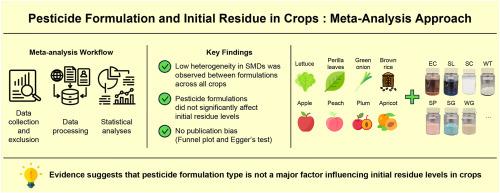Effect of pesticide formulation on initial residue levels in crops: a meta-analysis approach
IF 7.3
2区 环境科学与生态学
Q1 ENVIRONMENTAL SCIENCES
引用次数: 0
Abstract
A meta-analysis was conducted to determine whether pesticide formulation significantly affects the initial residue levels across different crops. Data from pesticide registration trials for three vegetable crops, four fruit crops, and one cereal crop were sourced from the Agricultural Materials Evaluation System database of the Rural Development Administration. After applying inclusion and exclusion criteria, 296 trials for lettuce, 113 for perilla leaves, 232 for green onions, 94 for apples, 206 for peaches, 230 for plums, 75 for apricots, and 144 for brown rice were selected. For each crop, trials using a specific formulation were grouped, the mean residue level and standard deviation were calculated for each group, and the residues from different formulations were then compared within the same crop. The standardized mean difference (SMD) was calculated for each crop using Hedges' g, and study heterogeneity was assessed using Cochran's Q-test and Higgins' I2-statistic. The Q values ranged from 1.91 to 12.59 (p > 0.13), and I2 values remained below 38 %, indicating no significant heterogeneity. A common effect model was then applied, yielding SMDs between 1.088 and 1.525 (95 % confidence interval). Funnel plots and Egger's test confirmed the absence of publication bias. In conclusion, the results showed that variations in pesticide formulation do not significantly affect initial residue levels in crops. The methodology and findings of this meta-analysis may support further investigation into the residual behavior of pesticides and the factors influencing pesticide residues in various crops.


农药配方对作物初始残留水平的影响:一项荟萃分析方法
进行了一项荟萃分析,以确定农药配方是否显著影响不同作物的初始残留水平。三种蔬菜作物、四种水果作物和一种谷类作物的农药登记试验数据来源于农村发展局的农业资料评价系统数据库。根据纳入和排除标准,莴苣296项、紫苏叶113项、大葱232项、苹果94项、桃子206项、李子230项、杏75项、糙米144项。对于每种作物,使用特定配方的试验进行分组,计算每组的平均残留水平和标准差,然后在同一作物内比较不同配方的残留物。采用Hedges ' g计算各作物的标准化平均差(SMD),采用Cochran ' s q检验和Higgins ' 2统计量评估研究异质性。Q值在1.91 ~ 12.59之间(p > 0.13), I2值保持在38%以下,异质性不显著。然后应用共同效应模型,得出smd在1.088和1.525之间(95%置信区间)。漏斗图和Egger检验证实了没有发表偏倚。综上所述,农药配方的变化对作物的初始残留水平没有显著影响。本荟萃分析的方法和结果可为进一步研究不同作物中农药残留行为和影响农药残留的因素提供支持。
本文章由计算机程序翻译,如有差异,请以英文原文为准。
求助全文
约1分钟内获得全文
求助全文
来源期刊

Environmental Pollution
环境科学-环境科学
CiteScore
16.00
自引率
6.70%
发文量
2082
审稿时长
2.9 months
期刊介绍:
Environmental Pollution is an international peer-reviewed journal that publishes high-quality research papers and review articles covering all aspects of environmental pollution and its impacts on ecosystems and human health.
Subject areas include, but are not limited to:
• Sources and occurrences of pollutants that are clearly defined and measured in environmental compartments, food and food-related items, and human bodies;
• Interlinks between contaminant exposure and biological, ecological, and human health effects, including those of climate change;
• Contaminants of emerging concerns (including but not limited to antibiotic resistant microorganisms or genes, microplastics/nanoplastics, electronic wastes, light, and noise) and/or their biological, ecological, or human health effects;
• Laboratory and field studies on the remediation/mitigation of environmental pollution via new techniques and with clear links to biological, ecological, or human health effects;
• Modeling of pollution processes, patterns, or trends that is of clear environmental and/or human health interest;
• New techniques that measure and examine environmental occurrences, transport, behavior, and effects of pollutants within the environment or the laboratory, provided that they can be clearly used to address problems within regional or global environmental compartments.
 求助内容:
求助内容: 应助结果提醒方式:
应助结果提醒方式:


